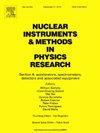High-granularity timing hodoscopes for the AMBER experiment
IF 1.5
3区 物理与天体物理
Q3 INSTRUMENTS & INSTRUMENTATION
Nuclear Instruments & Methods in Physics Research Section A-accelerators Spectrometers Detectors and Associated Equipment
Pub Date : 2025-07-19
DOI:10.1016/j.nima.2025.170837
引用次数: 0
Abstract
The AMBER experiment at CERN will measure the proton’s charge radius via muon-proton elastic scattering at high projectile energies and small momentum transfers to help to resolve the so-called proton radius puzzle, i.e., the discrepancy between charge radii measured with different experimental techniques. The core setup at AMBER consists of a hydrogen-filled time projection chamber (TPC). Tracking detectors upstream and downstream of the TPC measure the trajectories of the incoming and outgoing muons to determine their scattering angles. To resolve pile-up hits in the tracking detectors, we are constructing four high-granularity hodoscopes from 500- scintillating-plastic fibers and arrays of silicon photomultipliers. In this contribution, we present the design of the scintillating-fiber hodoscopes and first results of test-beam measurements with scaled-down prototypes. We will particularly emphasize how we managed to design detectors with a low material budget.
琥珀实验用高粒度定时窥镜
欧洲核子研究中心的AMBER实验将通过在高抛射能量和小动量转移下的介子-质子弹性散射来测量质子的电荷半径,以帮助解决所谓的质子半径难题,即不同实验技术测量的电荷半径之间的差异。AMBER的核心装置由一个充满氢的时间投射室(TPC)组成。TPC上游和下游的跟踪探测器测量入射和出射μ子的轨迹,以确定它们的散射角。为了解决跟踪探测器中的堆积撞击问题,我们正在用500 μm的闪烁塑料纤维和硅光电倍增管阵列构建四个高粒度的hodoscopic。在这篇文章中,我们介绍了闪烁光纤窥镜的设计和按比例缩小原型的测试光束测量的第一个结果。我们将特别强调我们如何设法以低材料预算设计探测器。
本文章由计算机程序翻译,如有差异,请以英文原文为准。
求助全文
约1分钟内获得全文
求助全文
来源期刊
CiteScore
3.20
自引率
21.40%
发文量
787
审稿时长
1 months
期刊介绍:
Section A of Nuclear Instruments and Methods in Physics Research publishes papers on design, manufacturing and performance of scientific instruments with an emphasis on large scale facilities. This includes the development of particle accelerators, ion sources, beam transport systems and target arrangements as well as the use of secondary phenomena such as synchrotron radiation and free electron lasers. It also includes all types of instrumentation for the detection and spectrometry of radiations from high energy processes and nuclear decays, as well as instrumentation for experiments at nuclear reactors. Specialized electronics for nuclear and other types of spectrometry as well as computerization of measurements and control systems in this area also find their place in the A section.
Theoretical as well as experimental papers are accepted.

 求助内容:
求助内容: 应助结果提醒方式:
应助结果提醒方式:


